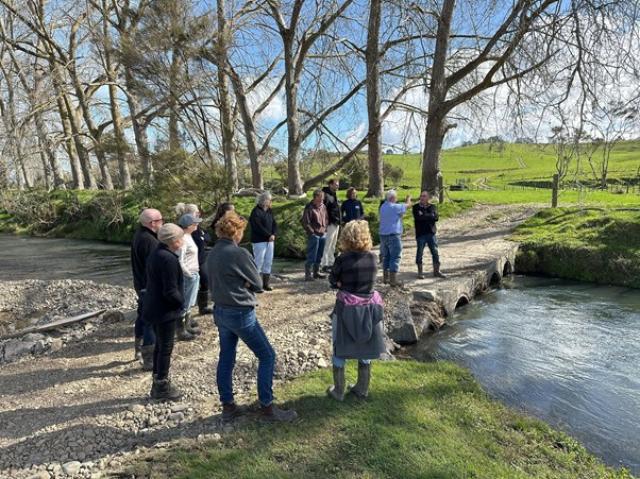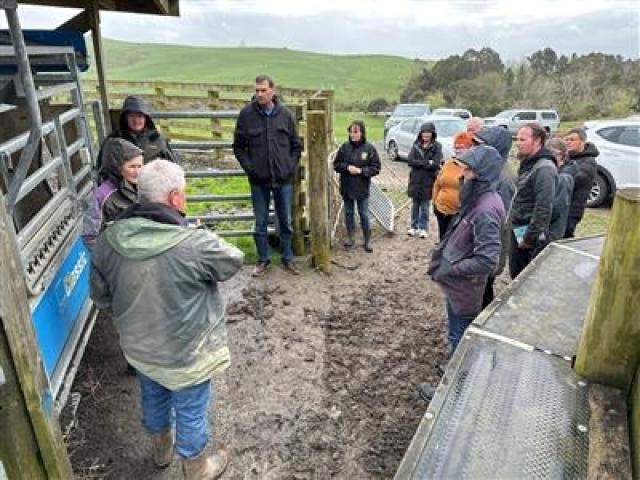Farmer-led catchment community groups are a great platform for building thriving farming communities, valued by all New Zealanders. They represent a rural voice helping build more resilient communities that can respond to local opportunities or issues.

The Mangatangi-Maramarua Catchment Community Group, in Waikato, was formed in 2021. Its vision is to protect and enhance the Mangatangi and Maramarua environment by involving the whole community.
Ko ahau te taiao, ko te taiao, ko ahau. I am the environment. The environment is me.
The Group’s key strategic areas include water quality; community and iwi involvement; biodiversity; climate change; and building partnerships with government and non-government agencies.
“Two years before we formed the community catchment group, a group of farmers were meeting regularly to try to help each other understand the numerous regulations that held significant implications for their farming operations. Initially focused on water quality, we quickly broadened to other areas such as biodiversity, sharing knowledge and providing a voice to their community,” says Will Murphy, Chair of the Mangatangi-Maramarua Catchment.
The Group has already achieved so much.
“One of our Group’s initiatives has focused on water quality. Our goal was to build data from 12 new water monitoring sites (including two real-time systems) within the Mangatangi and Maramarua waterways. Using the latest technology, and partnering with a water consultant, we now have data looking at turbidity, nitrogen, sediment, temperature, and E. coli, which shows a positive picture with several levels meeting or above the national standards,” says William.
“As the months pass, seasonal comparative data will provide a deeper understanding on how land use, weather events, temperature, and seasonality impacts water quality.
“The Group has also invested in an online mapping system called ‘Our Living Catchment’. This is an interactive, online tool to capture events and record on and off-farm activities. Members upload information and photographs, such as recent plantings, weather events, sightings of pests, or examples of biodiversity etc.
“The 12 water monitoring sites are shown and their corresponding data. Rainfall records are current and stretch back to 1962. It is a working, living repository that is useful today and will provide substantive historical information for the future.”
The Group has held a range of community workshops and events covering a range of topics from Fresh Water Farm Plans, farm field trips, calf and lamb days, pest control, First Aid courses and even a ‘spud in the bucket’ competition.
“This activity is drawing our community into a positive, collaborative collective, where knowledge and resources are shared, skills are transferred, new relationships are established, and we are improving our shared environmental and community wellbeing,” adds Robyn Budd, MMC Catchment Coordinator.
Robyn acknowledges the B+LNZ partnership and support and funding from several organisations has been of significant value.
“B+LNZ has been the lead agency in delivering workshops for the catchment. This has supported the production of environmental farm plans and allowed us to better understand the new legislative requirements around freshwater,” adds Robyn.
So, what’s next for the Mangatangi-Maramarua Catchment Community Group.
“In the short term, for the remainder of the year, we’ll focus on a biodiversity audit and a catchment-wide pest control initiative. The biodiversity audit will build a clearer picture of the catchment’s characteristics and challenges, while the catchment-wide pest control initiative aims to strengthen the results of individual pest control efforts within the community, resource new and effective tools, and share proven pest management plans. “

Robyn is keen to share the Group’s experience hoping this will provide helpful advice to other catchment groups in its early stages or those thinking of setting up a group.
“Early on we looked for support from relevant agencies, not just for funding but knowledge, tools and advice. We also decided that using local businesses and employing local people to deliver initiatives and programmes would bring benefits back into the community – things like fencing contractors, facilities hire, locally-sourced plants and web designers – all these services could be found within the catchment.
“Relationships built on trust and respect are crucial. We work closely with the community and stakeholders, along with residents, new lifestyle block owners, tenants, contract farm workers, teachers, city commuters and farmers. Irrespective of background or culture, we work together, share ideas and information to build a resilient, knowledgeable community where everyone is valued.
“Finally, I would like to acknowledge and thank the following for their invaluable support: Adriot, B+LNZ, Fire and Emergency NZ, Greenlea Ltd, Lightwire, MPI, NZ Landcare Trust, Red Meat Action Network, a Primary Growth Partnership with MPI and 11 industry partners, Rural Support Trust, Tainui Mercury Partnership, Total Ag, Waikato Regional Council, Waikato River Authority and Watercare.”
B+LNZ encourages and supports farmers to take active roles in local catchment community groups.
We offer farmers and catchment community groups a range of resources to support your work including e-forums, e-learning modules, a national catchment map, catchment facilitation training, podcasts, and fact sheets. As well as this, we also offer farm plan workshops and a range of other resources available on our Knowledge Hub.

